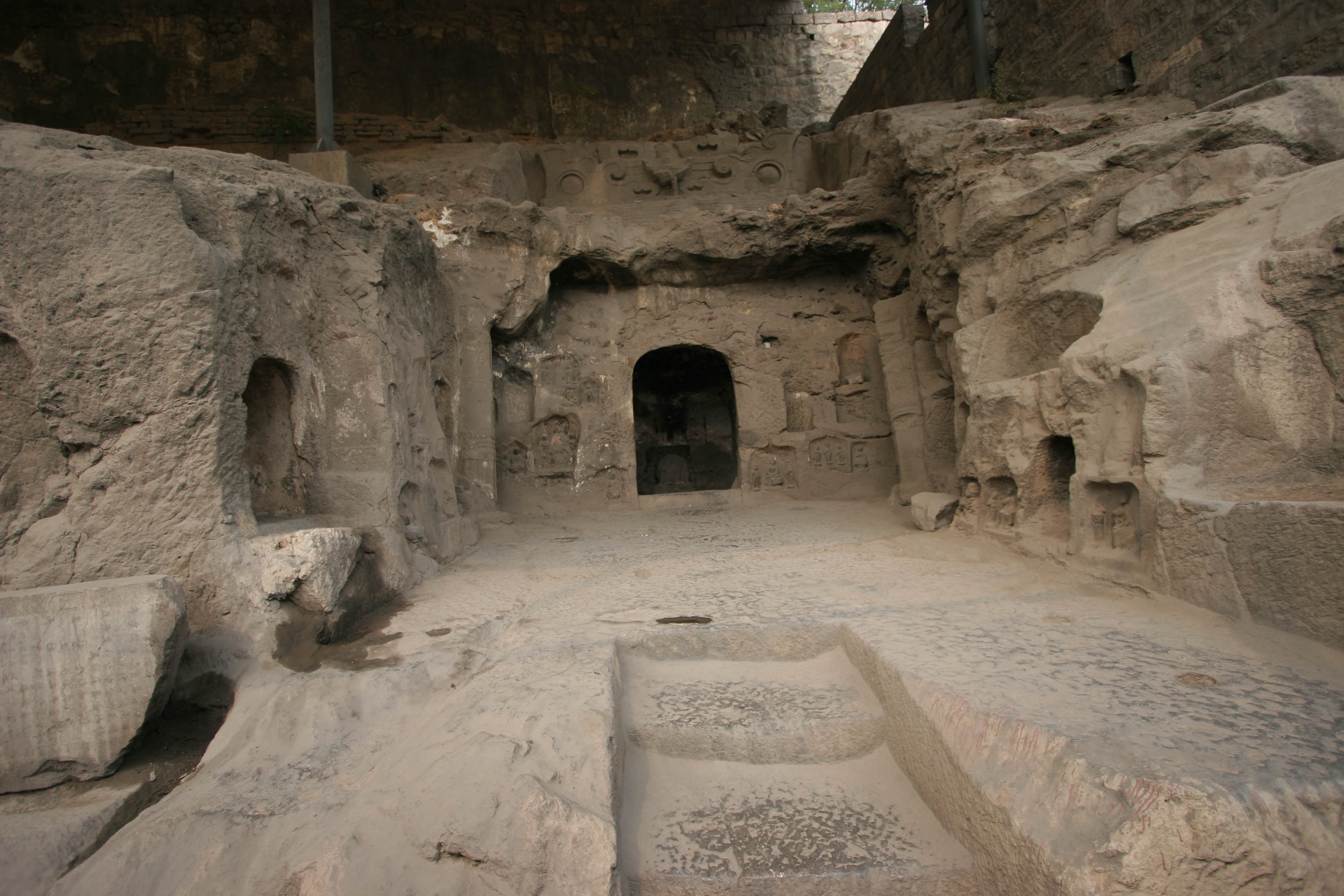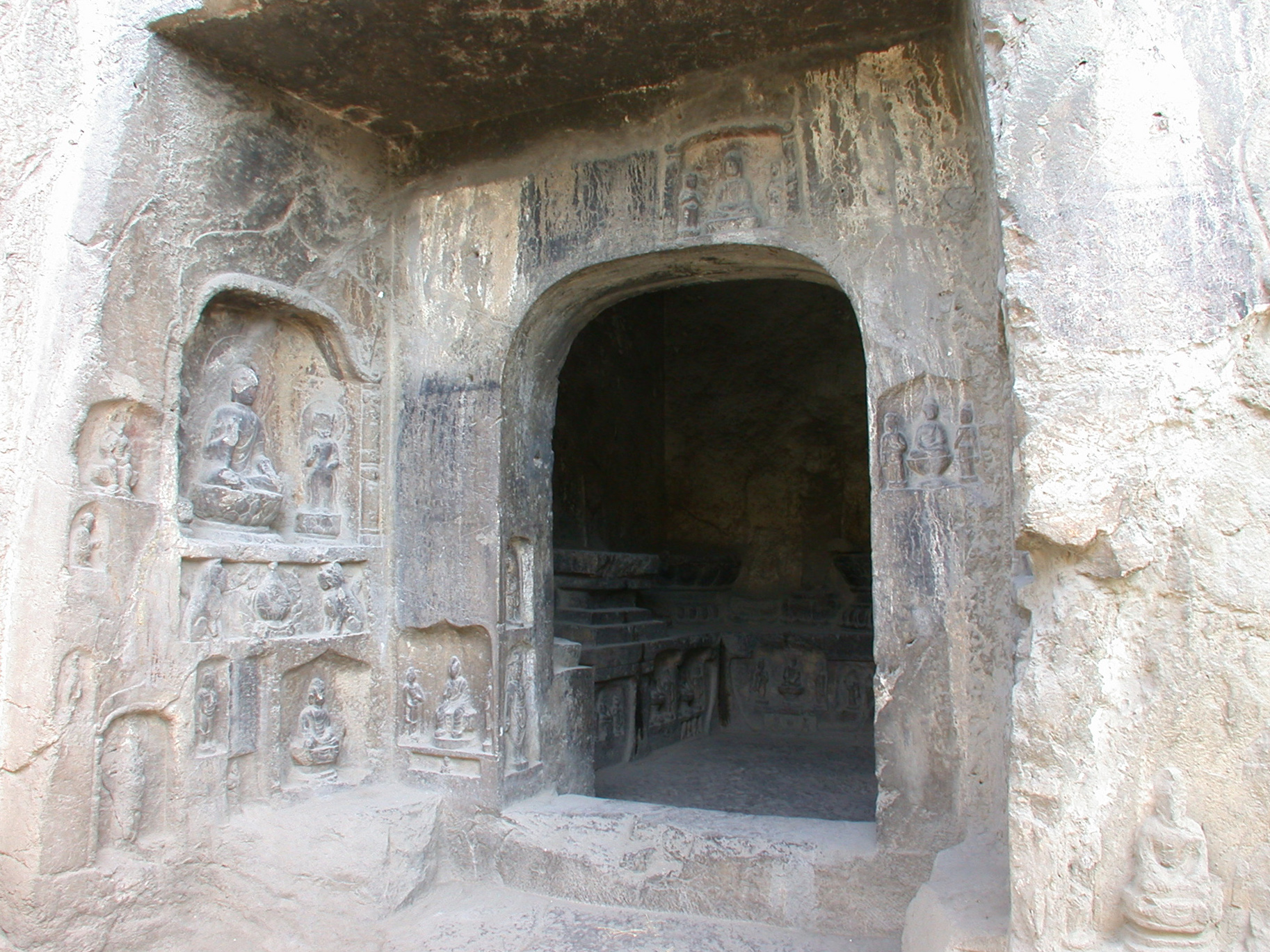South Site | Caves 3 - 6
Xiangtangshan Caves 4 - 6 exterior

On the upper level southeast side, Cave 3 has rather deep a courtyard in front that is set back from the cliff face above Cave 1. It is a small cave with shallow niches around three walls. There are no sculpted images remaining in their original locations in the cave. On the exterior, there are architectural details carved in stone—the remains of columns, and a stone eave with a bird standing on it in front of the roof. Part of the roof has been cut down because of later construction of a wooden temple building above the caves. From these remains, however, and their similarity to the features of Northern Qi Buddhist caves, it is evident that Cave 3 also had a carved domed roof.
Cave 3 roof
Cave 3 courtyard left
Cave 3 courtyard right
Cave 3 interior
Cave 3 interior left wall
Originally Cave 4 was part of a group of three caves, together located directly above Cave 2. Cave 4 and Cave 6 form a pair, with Cave 5 in the middle. Historic photographs show that Caves 4 and 6 had Buddhas and bodhisattvas seated on lotus thrones accompanied by standing attendant figures on an altar around three walls. Today there are no long any sculpted figures. Because the sculpted figures were not attached to the thrones or walls of the cave they were relatively easily removed and have left no traces but for the thrones and pedestals. In the middle of the twentieth century, even these were cut away to make room for storage. Some of the fragments of fine sculptures remaining at this site can be identified as originating from Cave 4. The engraving of an excerpt from the Lotus Sutra still remains intact on the upper part of the cave. It is the chapter entitled the “Universal Gateway of Avalokiteśvara,” or Guanshiyin pumen pin (also known as the Guanyin sutra) describing the benefits of faith in Avalokiteśvara, the bodhisattva of mercy, who has powers to take many forms to save those in need of help.
Cave 4 interior back wall
Cave 4 interior front wall
Outside the entrance to Cave 5, there are traces of columns supported formerly on the backs of lions. In addition, a row of post holes in front of Caves 4-6 suggest that there was formerly a wooden porch that extended in front of these caves. The interior of Cave 5 has niches cut into three walls, each with a seated Buddha and enough space for a pair of standing attendant figures. The Buddhas are largely intact though missing their heads. However, the freestanding attendant figures have been removed. Small relief sculptures on the upper part of the cave refer to scenes of the life of the Buddha. The parinirvana or death of the Buddha appears above the door. On the ceiling, a lotus flower appears in relief around which small flying divinities; most of them have been cut away.
Cave 5 back wall
Cave 5 ceiling
Cave 5 front wall with Mahaparinirvana scene
Cave 5 left wall
Cave 5 right wall

The entrance to Cave 6 has a large niche of the Sui dynasty carved on both sides. Other smaller carvings of later periods appear on the façade and on the front of the altar inside.
The altar extends around three walls of Cave 6 still has most of the original thrones and pedestals of the sculptural figures remaining. These preserve the positions of the sculpted images in the cave and show that many were free-standing figures. Unlike the principle images at Northern Xiangtangshan, many of the sculptures at this site were carved outside of the caves perhaps in workshops and the finished sculptures placed into the caves. Historic photographs provide evidence of the appearance of some of the original groups of sculptures, though some were repaired by that time already. Fragments of the seated Buddhas and bodhisattvas still remain at the site though their heads have been taken.
Cave 6 interior
The altar extends around three walls of Cave 6 still has most of the original thrones and pedestals of the sculptural figures remaining. These preserve the positions of the sculpted images in the cave and show that many were free-standing figures. Unlike the principle images at Northern Xiangtangshan, many of the sculptures at this site were carved outside of the caves perhaps in workshops and the finished sculptures placed into the caves. Historic photographs provide evidence of the appearance of some of the original groups of sculptures, though some were repaired by that time already. Fragments of the seated Buddhas and bodhisattvas still remain at the site though their heads have been taken.
Cave 6 front wall
Cave 6 left wall
Cave 6 right wall
